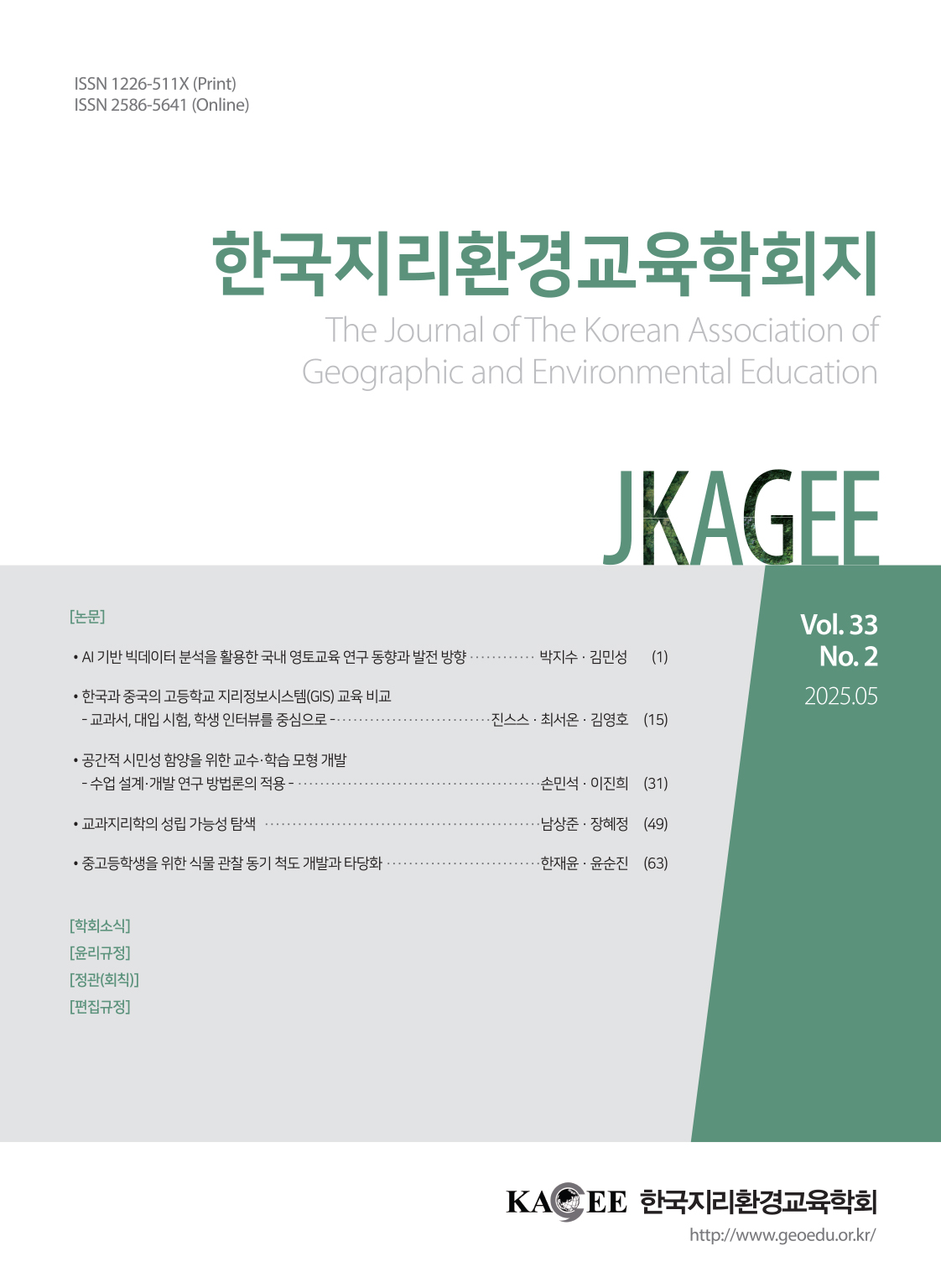Research Article
Abstract
References
Information
The purpose of this study is to analyze the potential of digital geo-poems, a synthetic activity of geography-themed poem writing and visual representation of geographic content using smartphone apps, as a method of geography teaching and learning. To proceed with the research, the corresponding author instructed 12th-grade students to construct digital geo-poems on geomorphology themes in Korean geography lessons. The data were collected from surveys and reflective journals, and the analysis was done through survey analysis and phenomenological analysis of the journals. As a result, digital geo-poem meaningfully encouraged the participants. Digital geo-poem helped develop their interests, motivation, and confidence in learning geography and enhanced their in-depth, contextual, and procedural understanding of geographical concepts. Consequently, most of the participants recognized digital geo-poem as an effective method for learning geography. These results suggest meaningful discussions on the improvement of geography learning.
본 연구는 스마트폰 글쓰기 앱을 활용하여 지리 주제의 시(詩) 쓰기와 지리 시각자료를 결합하는 형태의 활동인 디지털 지오포엠이 지리 수업 방식으로서 갖는 교육적 효과를 분석하는데 목적을 둔다. 연구 진행을 위해, 고등학교 3학년 학생들을 대상으로 지형 개념을 주제로 한 디지털 지오포엠을 창작하는 형태의 한국지리 수업을 진행하였다. 자료의 수집 및 분석은, 수업 후 학생들이 작성한 설문지 분석 및 성찰일지의 현상기술학적 분석을 통해 이루어졌다. 분석 결과, 디지털 지오포엠 활동은 연구참여자들의 지리 학습에 대한 흥미와 학습 동기, 자신감의 향상, 지리 개념에 대한 심층적‧맥락적‧절차적 이해에 의미 있는 기여를 하였다. 이에 따라 대부분의 연구참여자들은 디지털 지오포엠을 유용하고 의미 있는 지리 학습 방법으로 인식하였다. 이 같은 연구결과는 지리 학습의 개선 및 발전 방안과 관련된 의미 있는 논의를 제시한다.
- 공광규, 2019, “문화예술 장르로 도약하고 안착해 가는 디카시”, 한국문학인, 48, 40-43.
- 권남희, 2020, “찰나의 잉여물과 문학적 몽타주(Montage)”, 월간문학, 615, 22-25.
- 김다원, 2015, “문학작품 읽기에서 장소에 대한 지리적 지식의 유용성 탐색 연구”, 한국지리환경교육학회지, 23(2), 75-87.
- 김명숙, 2012, “문학의 위기에 관한 담론: 프랑스와 한국의 경우”, 비교문학, 56, 237-255.
- 김묘정, 2007, “사회사적 관점에서 본 우리나라 도시빈민의 형성배경과 주거문화: 한국전쟁 이후 집단이주민촌부터 외환위기 이후 신빈곤층 주거까지”, 한국주거학회논문집, 18(4), 79-88.
- 김용희, 2020, “소셜 미디어 시대의 문학 환경”, 월간문학, 614, 33-42.
- 김민성, 2019, “공간적 관점 및 도구와 역사적 콘텐츠의 융합”, 한국지리환경교육학회지, 27(4), 55-68.
- 김민성, 2020, “지리에 대한 인식 조사: 지리 전공과 비전공 대학생 비교를 중심으로”, 한국지리환경교육학회지, 28(1), 33-47.
- 김민성‧류재명, “지리교육을 통한 변혁적 리더십 함양”, 한국지리환경교육학회지, 27(2), 99-112.
- 김현주, 2014, “지리 교육에서 스포츠의 활용 방안”, 한국지리환경교육학회지, 22(3), 85-101.
- 박진숙, 2006, “일제하 “조선적인 것”의 기원과 형성: 식민지 근대의 심상지리와 『문장』파 기행문학의 조선표상”, 민족문학사연구, 31, 64-93.
- 박철웅‧김진수‧조성호‧강은희‧이강준‧최재희‧백승진‧김지현, 2020, 한국지리, 미래엔.
- 박현애‧배성우‧박종석, 2014, “과학교육의 태도와 흥미 연구에서 리커트 척도 활용의 유의점”, 한국과학교육학회지, 34(4), 385-391.
- 송언근, 2002, “지형 지식의 인식론적 특성과 존재론적 지형 교육”, 대한지리학회지, 37(3), 262-275.
- 송언근‧이동민, 2014, “교실 지리 탐구에서 스케일, 차원, 재현의맥락에서 본 구글 어스의 자료적 의미: 서재리 구유로를 중심으로”, 한국지리환경교육학회지, 22(1), 79-94.
- 심승희, 2001, “문학지리학의 전개과정에 관한 연구: 토머스 하디의 소설을 중심으로”, 문화역사지리, 13(1), 67-84.
- 심승희, 2012, “지리학과 지리교육이 문학에 접근하는 방식”, 한국문학교육학회, 37, 87-124.
- 전재원, 2019, “북매핑(Bookmapping)을 활용한 초등 세계 지리 학습의 지리 교육적 의의”, 학습자중심교과교육연구, 19(8), 495-518.
- 이동민, 2018, “시바 료타로(司馬遼太郎)의 「한나라 기행(韓の国紀行)」에 재현된 한국을 바라보는 시선에 관한 연구”, 한국지리학회지, 7(3), 363-386.
- 이동민, 2020, “김사량의 소설 『물오리섬』에 대한 문학지리적 연구”, 문화역사지리, 32(1), 191-210.
- 이민부‧김정혁‧최훈, 2014, “자연지리 답사를 통한 지역화 교육 프로그램의 개발과 운영: 미호천 유역 하천지형을 사례로”, 한국지형학회지, 21(4), 53-67.
- 이희상, 2008, “대중지리와 학교지리의 문화적 텍스트로서 모험소설 읽기: 쥘 베른의 『80일간의 세계일주』를 사례로”, 한국지리환경교육학회지, 16(3), 215-235.
- 정희선, 2018, “『이사벨라 버드 비숍의 황금 반도(The Golden Chersonese and the Way Thither)』에 나타난 제국주의적 시선과 여성 여행자로서의 정체성”, 대한지리학회지, 53(1), 59-74.
- 최호영, 2019, “디카시(dica-poem)의 이미지 구현 방식과 뉴미디어 시대의 문학 공간”, 한민족어문학, 85, 209-241.
- Alexander, B., 2017, The New Digital Storytelling: Creating Narratives with New Media, Santa Barbara, CA: Praeger.
- Bertland, C., 2017, The bleeding heart of criminal geography in Dickens’ London, in Murail, E., and Thornton, S., eds., Dickens and the Virtual City: Urban Perception and the Production of Social Space, London: Palgrave Macmillan, 79-98.10.1007/978-3-319-35086-8_4
- Bradbeer, J., Healey, M., and Kneale, P., 2004, Undergraduate geographers' understandings of geography, learning and teaching: a phenomenographic study, Journal of Geography in Higher Education, 28(1), 17-34.10.1080/0309826042000198611
- Dahlgren, L. O., and Fallsberg, M., 1991, Phenomenology as a qualitative approach in social pharmacy research, Journal of Social and Administrative Pharmacy, 8, 150-156.
- de Klerk, M. M., 2001, Historicizing the landscape: recovering the aesthetics of the Alhambra, An unpublished M.A. dissertation of the Massachusetts Institute of Technology.
- Duncan, I., 2002, The provincial or regional novel, In Brantlinger, P., and Thesing, W. B.(eds.), A Companion to the Victorian Novel, Oxford, UK: Blackwell Publishing, 318-335.10.1002/9780470996324.ch19
- Egiebor, E. E., and Foster, E., 2019, Students’ perceptions of their engagement in using GIS-Story Maps, Journal of Geography, 118(2), 51-65.10.1080/00221341.2018.1515975
- Ekelund, B. G., 2002, ‘The Age of Criticism’: debating the decline of literature in the US, 1940-2000, Poetics, 30, 327-340.10.1016/S0304-422X(02)00028-1
- Józsa, K., and Morgan, G. A., 2017, Reversed items in Likert scales: filtering out invalid responders, Journal of Psychological and Educational Research, 25(1), 7-25.
- Khan, S. H., 2014, Phenomenography: a qualitative research methodology in Bangladesh, International Journal on New Trends in Education and Their Implications, 5(2), 34-43.
- Kozak, E., 2017, Dmitry Glukhowsky as a brand: between literary creativity and self-representation, Journal of Siberian Federal University. Humanities and Social Sciences, 5, 733-740.10.17516/1997-1370-0079
- Lane, R., Carter, J., and Bourke, T., 2019, Concepts, conceptualization, and conceptions in geography, Journal of Geography, 118(1), 11-20.10.1080/00221341.2018.1490804
- Lee, D.-M., 2020, Cultivating preservice geography teachers’ awareness of geography using Story Maps, Journal of Geography in Higher Education, 44(3), 387-405.10.1080/03098265.2019.1700487
- Luchetta, S., 2018, Going beyond the grid: literary mapping as creative reading, Journal of Geography in Higher Education, 42(3), 384-411.10.1080/03098265.2018.1455172
- Moretti, F., 1998, Atlas of the European Novel. 1800-1900, London: Verso.
- Parsayi, F., and Soyoof, A., 2018, Video games: the interface between language learning and storytelling, International Journal of Pedagogies and Learning, 13(2), 103-118.
- Samutina, N., 2016, Fan fiction as world-building: transformative reception in crossover writing, Continuum, 30(4), 433-450.10.1080/10304312.2016.1141863
- Sedikides, C., Wildschut, T., and Baden, D., 2014, Nostalgia: conceptual issues and existential functions, In Greenberg, J., Koole, S. L., and Pyszczynski, T.(eds.), Handbook of Experimental Existential Psychology, New York: The Guilford Press, 200-214.
- Stenfors-Hayes, T., Hult, T., and Dahlgren, M. A., 2013, A phenomenographic appraoch to research in medical education, Medical Education, 30(2), 367-372.
- Walford, R., 2001, Geography’s Odyssey: the journey so far, Geography, 86(4), 305-317.
- Publisher :The Korean Association Of Geographic And Environmental Education
- Publisher(Ko) :한국지리환경교육학회
- Journal Title :The Journal of The Korean Association of Geographic and Environmental Education
- Journal Title(Ko) :한국지리환경교육학회지
- Volume : 28
- No :3
- Pages :27-42
- DOI :https://doi.org/10.17279/jkagee.2020.28.3.27



 The Journal of The Korean Association of Geographic and Environmental Education
The Journal of The Korean Association of Geographic and Environmental Education







